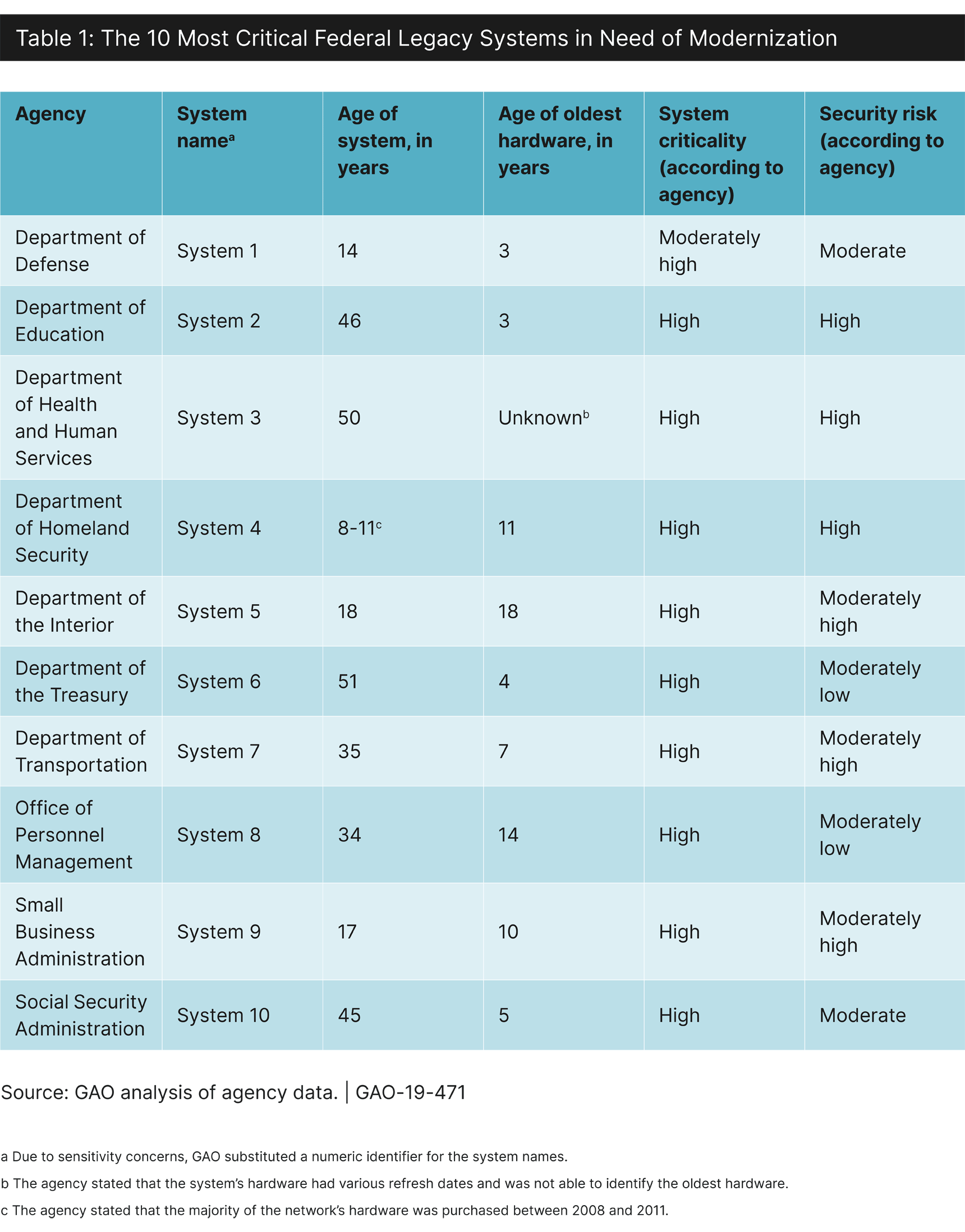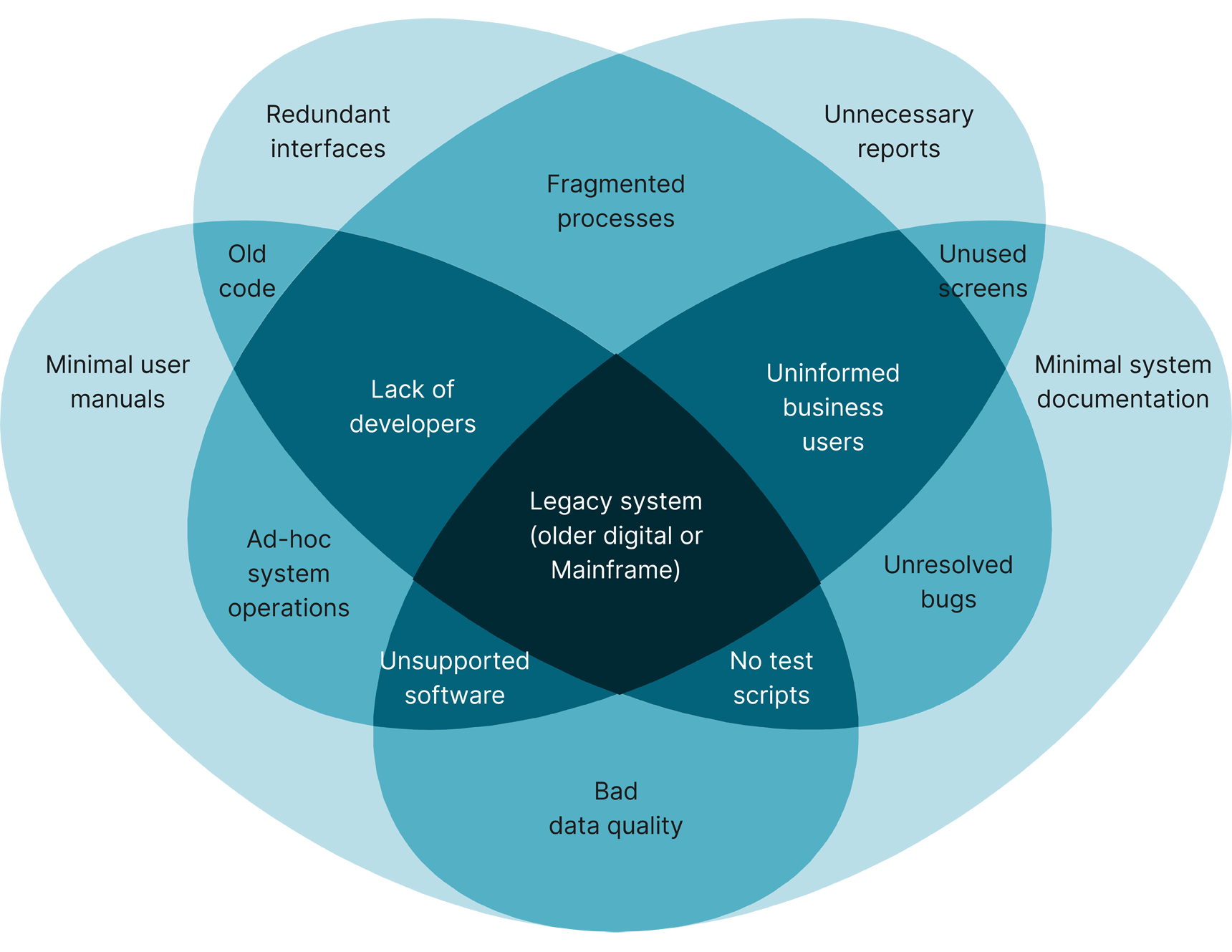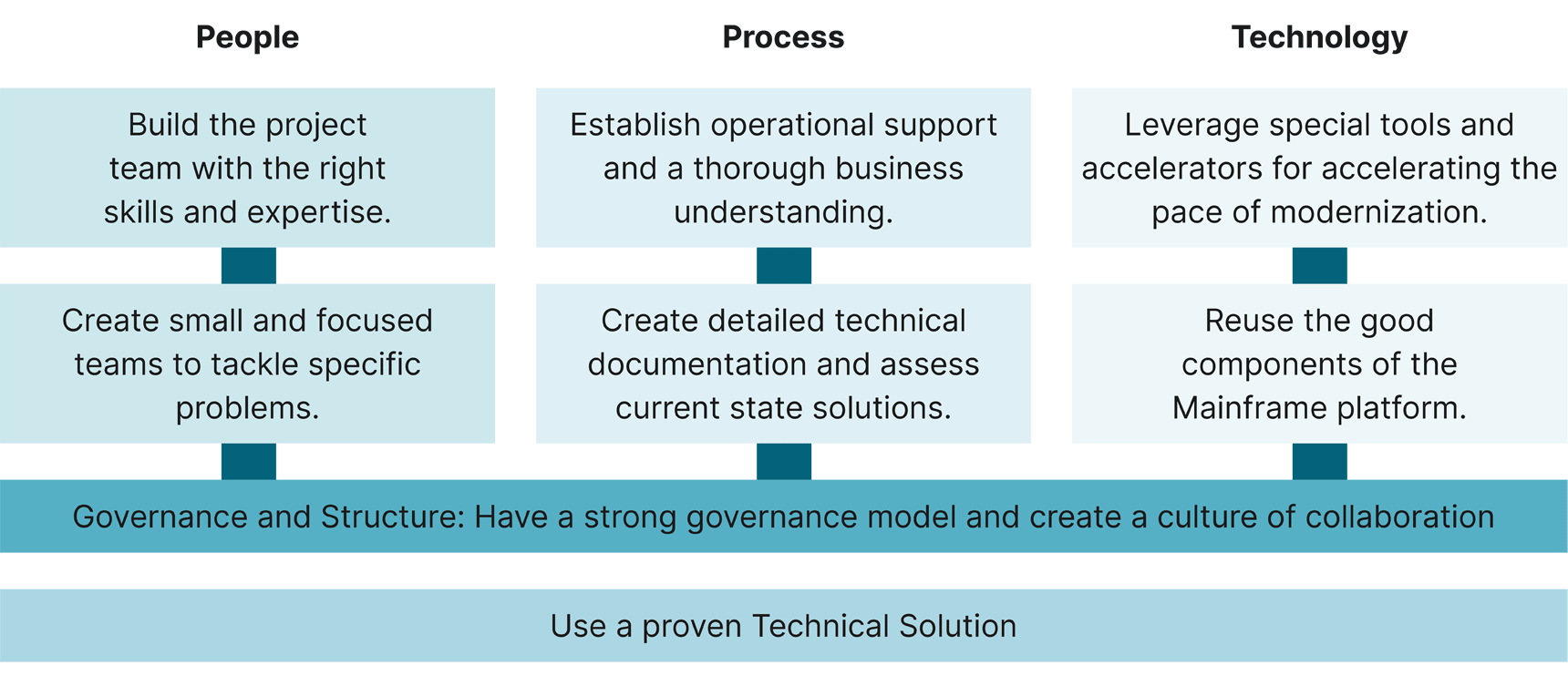Outdated systems continue to challenge government agencies – leaving them vulnerable to cyberattacks, and unable to address market changes, all while managing redundant processes, just to maintain business as usual. While updating these systems has a significant upfront cost, neglecting them can and often does present risk to many agencies. During recent Congressional testimony, the US Government Accountability Office (GAO) highlighted 10 of the 15 federal agencies investigated had 249 systems vulnerabilities, of which 168 posed significant risk to the security of their operations.

Each year, Congress appropriates approximately $100 billion toward modernization and 80% is allocated to maintain these antiquated systems. Federal agencies continue to struggle with the proactive planning and budgeting needed; upgrade underlying infrastructure; and investing in high quality, lower cost service delivery technology. As a result, agencies continue to be exposed to security risks, unmet mission needs, staffing issues, and increased costs.
The key question: How can agencies successfully transform from outdated technologies to less expensive, more agile systems that can mitigate security risk, improve taxpayer services, and reduce support costs?
Mainframes and Outdated Digital Environments Probably Have Significant Risks
While mainframes and legacy digital environments run the most critical operations of several agencies, they have reached a point where the incremental benefit of maintaining them dwarfs the incremental costs. Failure to modernize these systems is likely causing chronic issues. Similarly, outdated digital environments not geared for today’s cyber challenges, data volume, and sophisticated technologies are probably lagging in capabilities, including:
- Security Risk — In many instances, outdated digital environments that are no longer supported by their vendors risk security exposures and additional costs. As a result, these systems often operate with known vulnerabilities that are either technically difficult or prohibitively expensive to address.
- Unmet Mission Needs — Many systems are too obsolete to support even basic mission functions and unable to flexibly respond to changing taxpayer demands and agency needs.
- Staffing Issues — For their operations, outdated systems need professionals experienced in older technologies, many of which have exited the market, resulting in a premium for these skills.
- Increased Cost — The cost of maintaining these outdated systems increases with time. The federal government's 10 legacy systems most in need of modernization cost about $337 million a year to operate and maintain, according to the GAO1. Agencies also lose the opportunity to utilize taxpayer dollars toward modernizing their systems.
When coupled with constantly shifting regulations, increasing demands from the business teams to meet the agency’s mission, advancement of latest technologies and tools to achieve faster time to market, and run a lean IT shop, the modernization of legacy systems needs an immediate call to action.
Transformation is Risky, but Not Doing so is Riskier
Transformation to current cloud and processing capabilities are risky for a variety of reasons. Our experience has found the highest risks stem from a few specific issues, based on the complexity and age of these systems.
The pace of technology change can pose the most significant challenges for many agencies. Due to aging systems, there are many unsupported environments. As a result, systems documentation is stale or non-existent or online support forums to provide user guidance to operate or modernize these systems are out of date.
In one of the system migrations performed by the Guidehouse team, the architecture was documented with sticky notes and unorganized papers that had not been updated in 10-plus years.

In many instances, the core team of developers, analysts, and business users have left the workforce, presenting a significant knowledge gap. The existing team is forced to run the system as-is, leaving the agency unable to make changes due to fear of breaking the existing programs. This leads to deterioration of the code and system components and increasing the level of effort required to modernize the system. Further, business users create “out-of-system” workarounds to fulfill their unmet requirements, leading to deterioration of data quality and program integrity.
Inconsistent formatting and input mechanisms for data in abstruse front-end user screens lead to unreliable data for reporting and operational functions. In fact, a recent migration performed by the Guidehouse team found 17 different calendar date formats across the various applications.
The inflexibility, lack of interoperability, and time to make changes to the existing architecture has forced technology teams to develop shadow and ancillary distributed systems to bypass the existing environment, increasing the number of interfaces and data exchanges (e.g., spreadsheets). Some of these interfaces are redundant and may not be required. The distributed applications get a life of their own and increase the complexity of core operational processes, leading to a “spaghetti” technology environment that becomes messy to untangle.
A Framework for Response
Based on our experience with several digital transformations, we have found a unique methodology to ensure the success of these failure-prone projects.

Our methodology delivers the right mix of technical and non-technical elements to ensure that a robust governance and team structure is built around a strong technical approach. This enables agencies to address the risks by leveraging the ideal operational, technical, communications, and training solutions. Not all issues need a technology solution and code build. Some problems can be managed through effective stakeholder management and prioritized needs of the business teams.
Key Success Factors for Digital Transformation
Change always starts with one step and, more often than not while zeroing in on the digital customer experience, uncovers areas of immediate opportunities to learn, experiment, and eliminate existing hurdles and points of friction in the customer journey. Undoubtedly, agencies must have fundamentally sound project management techniques, a robust decision framework, and good technology skills as the backbone of any major transformation.
Based on our extensive experience, we have identified the following success factors across the Governance and Structure, People, Process, and Technology pillars of a project:
Orientation
- Establish a new perspective to drive meaningful change. If your organization is built on the “inside out” model, meaning that it is organized around your internal processes and functions, update to focus on customer needs, wants, and priorities.
People
- Understand customer values, expectations, and behaviors. This requires digital transformation buy-in at all levels—all employees and leadership—so that the entire organization is aligned with digital goals and strategies. Build the project team with the right skills and expertise. Assembling the right team with the skills required to analyze the existing components, like functional needs of the users, online user interfaces, APIs, load balancing, cloud design, etc., is critical. Often, confusing requirements and one-off scenarios are embedded in an existing digital environment and even the operations team may not be aware of the specific use cases. A typical response during the requirements-gathering session often comes down to: “That is what the system does.” These scenarios may seem innocuous, but should not be ignored, as they may impact the overall accuracy of the system functionality.
- Create small and focused teams to tackle specific problems. There will be numerous issues, ranging from technical to communications and training, that pop up during digital transformation projects. It is key to have agile teams to tackle the issues at hand and resolve them in an expeditious manner. These teams should be nimble, focused, and have the right mix of technical and non-technical skills. In a mainframe modernization that Guidehouse recently completed, we created tiger teams to test more than 200 user points of interface in just two months, helping the project meet the ultimate deadline.
Processes
- Assess operational infrastructure and update (or revamp) technologies, processes, and policies to support change. Start with the contact center, which is a key platform for delivering great customer experiences, and make it collaborative, unified, and intelligent.
- Establish operational support and a thorough business understanding. A thorough understanding of the operations and business functions is the foundation for any modernization effort. With the passage of time, not only do the systems become obsolete, but also the processes become outdated and inflexible to meet the ever-changing business needs. As part of the transformation project, Guidehouse recommends the creation of a detailed concept of operations, functional use and Requirements Traceability Matrix to validate the system design and implementation requirements. Additionally, we suggest documenting detailed process flows (e.g., as-is and to-be), wireframes, and mock-ups to detail the page design elements, user interface requirements, and templates needed for data conversion. An agile approach to requirements gathering/definition by using epics, stories, story points, and burndown charts helps with new discoveries and findings during the project.
- Create detailed technical documentation and assess current-state solutions. Using the concept of operations and detailed operational procedures, detailed technical requirements need to be developed as part of the overall discovery and analysis process. This should include the end-to-end-technology thread to support the operations: specific screens or web pages, data files, cloud or other points, reports, and interfaces to tie the business and technology components together.
Objectives
- Define the purpose of digital transformation, aligning stakeholders (and shareholders) around the new vision and roadmap. Set goals for your digital transformation—what specific areas do you hope to improve through digital? What kind of metrics are you hoping to achieve? Setting quantifiable key performance indicators can help ensure that you meet your digital transformation objectives.
Structure
- Form a dedicated digital experience team with roles/responsibilities/objectives/accountability clearly defined. Ensure the entire team is aware of objectives and processes so that you are centered on purpose.
Insights & Intent
- Gather data and apply insights toward a strategy to guide digital evolution. Data can help you streamline experiences across customer journeys, no matter how they interact with your brand. Data can also help you evaluate the results—brand relevance, increased revenue, and more—of your digital transformation.
Technology
- Re-evaluate front- and back-end systems for seamless, integrated, and native customer experiences and, ultimately, employee experiences. Use technology to promote trustworthiness and meet ever-increasing customer expectations. Ensure your content and communications are platform-proof so that algorithm changes do not interfere with customer experience.
- Leverage special tools and accelerators for increasing the pace of transformation change. For each component, specific tools and a strong network of technology tool providers are critical to resolve these bespoke issues. There could be third-party content providers that are critical to users. We recommend identifying and partnering with these vendors early in the project to ensure roadblocks are resolved quickly.
- Reuse the good components of the existing digital platform. Not all the components and solutions embedded in the existing digital servers are bad and disposable. A key element of success is to distill the useful pieces and reuse them in the modernized solution. This can range from simple modules of code, embedded business rules, and some external interfaces. While doing this involves reverse engineering pieces of the current digital environment, it helps clarify requirements and expedites the delivery of the new system.
Execution
- Implement, learn, and adapt to steer ongoing digital transformation and customer experience work. Evaluate the state of your transformation frequently so you can adjust if necessary.
Governance and Structure
- Have a strong governance model and create a culture of collaboration. Transforming a Digital environment is complex and involves large teams. Additionally, they have a lot of moving pieces and rarely go as planned. To prepare for this, a strong governance model with clear roles and responsibilities for each team member, and a nimble decision-making process to resolve risks and issues as soon as possible are critical to project success.
Guidehouse's Experience in Digital Transformation
While there are many technical support opportunities to transform an existing digital platform, agencies need to adopt a path that helps them assess the comparative and aggregate value (business, technical, and economic) of these legacy environments. More importantly, with limited money and time, agencies need an application portfolio management strategy that is efficient and delivers effective IT, both during and post-transition. A solution that aligns the IT investments to business value while enabling prioritization of key initiatives provides the best chances of success.
Guidehouse takes a business-focused, platform-agnostic application rationalization approach when transforming digital environments, while reducing cost and complexity found in redundant systems. Our proven Application Rationalization methodology leverages business value (application to function mapping and user impact analysis) and technology health (technology lifecycle and platform redundancy) of each application. This approach enhances the modernization strategy (Rearchitect, Replatform, Rehost, Retire) for applications, enabling strategic initiatives and a long-term portfolio roadmap.
Our solutions can methodically accelerate an agency’s migration from prior generation digital platforms, enabling faster return on investment. Our expertise helps mobilize agency operational and technical resources to develop and execute the modernization solution. This model has brought repeated implementation success for government agencies.
 Search
Search




